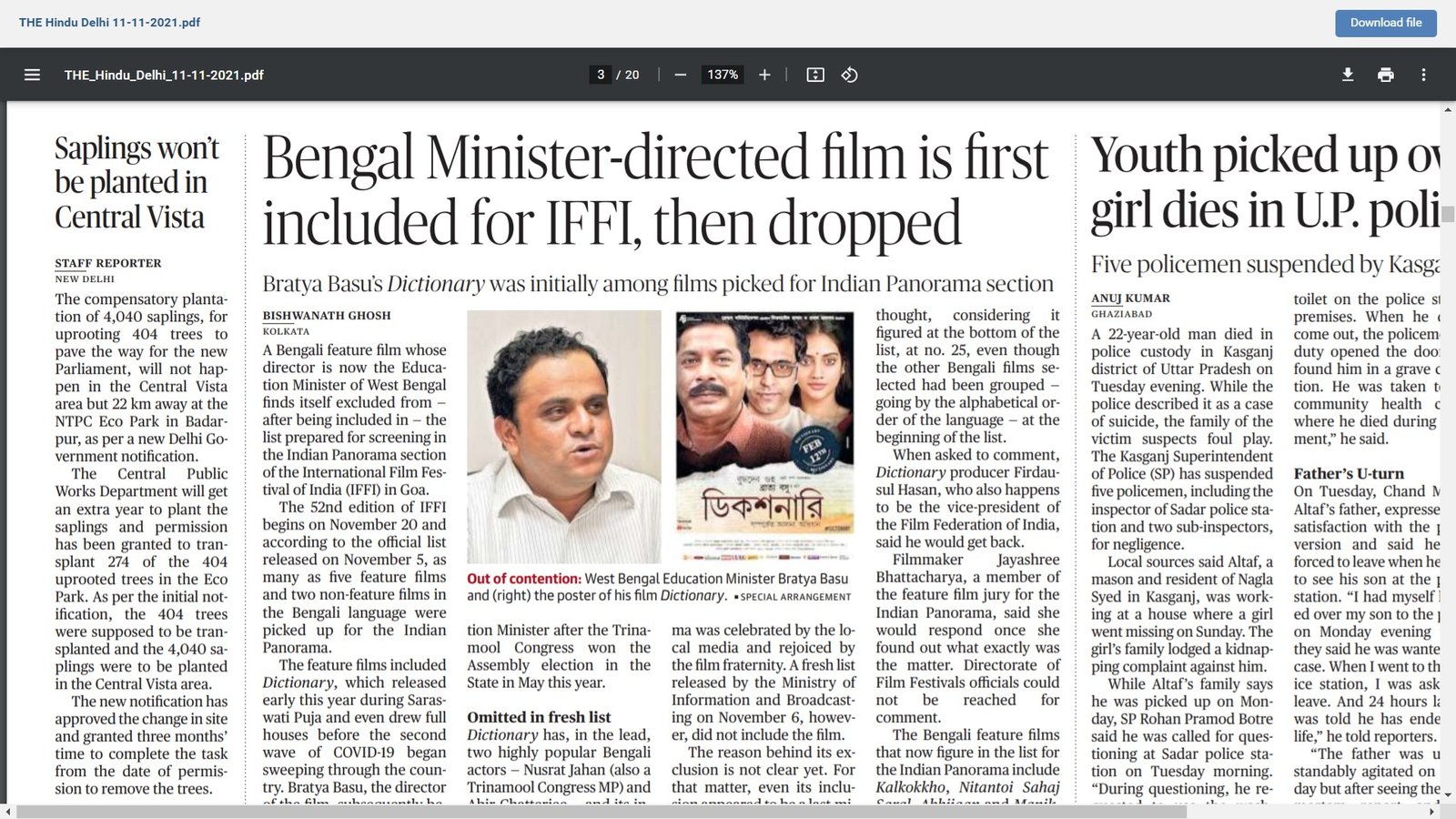
Prepare IAS Coaching
Current Affairs

Title : SAPLINGS WON'T BE PLANTED AT CENTRAL VISTA, 1th November 2021
Date : Nov 11, 2021
Description :
Based on an Article published in ‘The Hindu’ on 11th November 2021 on Page Number 1 and 6:
Useful for UPSC CSE Prelims and Mains (GS Paper I and GS Paper III)
What is Central Vista Project:
- Central Vista is a 3.2 kilometre stretch in Delhi which houses Rashtrapati Bhawan, Parliament House, North and South Block, India Gate, National Archives among others.
- All these iconic buildings were constructed before 1931, the year in which the new capital was inaugurated.
- The Central Vista Redevelopment Project is a government’s plan for the construction of a new parliament building which will be close to the existing one.
Overview of the Central Vista Project:
- The Union Ministry of Housing and Urban Affairs proposed a Central Vista redevelopment project in 2019.
- The project intends to construct a triangular-shaped Parliament building next to the existing one, construction of Common Central Secretariat, revamp of the 3 kilometres long Rajpath from Rashtrapati Bhavan to India Gate.
- It also includes the conversion of North and South Blocks into museums and the development of Central Vista Avenue.
- To accommodate the offices of various ministries, 87 storied buildings will be built for the common Central Secretariat.
- Nirman Bhavan, Krishi Bhavan, and Vigyan Bhavan will be demolished under this project
Need of Revamping under the Central Vista Project:
- Inadequate facilities and infrastructure of the Parliament building to meet the current demand.
- The offices of the Central Government are spread over different locations which affect inter-departmental coordination, and unnecessary travel leading to congestion and pollution.
- Most of the existing buildings have outlived their structural lives.
Aim of the Central Vista Project:
- This project is proposed to meet the present & future needs of space for Parliament, Ministries and Departments, as well as to provide better public facilities, amenities, parking facilities, etc.
- Citing fire safety, acoustics concern, the dilapidated condition of the century-old construction, the redevelopment project is planned.
- Under this ambitious project, there will be a new Parliament building by July 2022 and a common Central Secretariat by March 2024.
- Once this project is completed, the strength of the parliament has been expected to increase from 545 seats to 900 seats.
- The project also envisions to improve the beauty of Central vista to make it a world-class tourist attraction.
Background of the Central Vista Project:
- In December 1911, King George V made an announcement in Delhi Durbar (a grand assembly) to shift the capital of India from Calcutta to Delhi.
- Delhi Durbar was hosted to mark the coronation of King George V.
- The task of constructing a new city was given to Edwin Lutyens, known for his strong adherence to European Classicism and Herbert Baker, a prominent architect in South Africa.
- Herbert Baker is also the architect of the Union buildings at Pretoria, South Africa.
- Parliament House building was designed by both Lutyens and Baker.
- Madhya Pradesh’s Chausath Yogini Temple inspired the design of Indian Parliament.
- Rashtrapati Bhavan was designed by Edwin Lutyens.
- The Secretariat which includes both north and south block was designed by Herbert Baker.
Central Government’s Stand on the Central Vista Project:
- Underlining the cost and infrastructure advantages of the proposed project, the Centre told the SC that the question whether or not to have a new Parliament building is a policy decision which the government is entitled to take.
- The government had taken an important policy decision to construct a Parliament complex and central secretariat as the existing one is under tremendous stress.
- Further, the project cannot come up at Noida or elsewhere, but on Central Vista.
Arguments Put Forward by the Central Government on the Central Vista Project:
- Pre Independence building: The current one was built in 1927 to house the legislative council and was not intended to house a bicameral legislature that the country has today.
- Lack of Space: The current building will be under more stress when the number of seats to Lok Sabha and Rajya Sabha are raised.
- Both Houses are already packed and members have to sit on plastic chairs when joint sessions are held, diminishing the dignity of the House.
- Safety Concerns: The existing building does not conform to fire safety norms.
- Water and sewer lines are also haphazard and this is damaging its heritage nature.
- Security concerns in the wake of the 2001 Parliament attack shows its vulnerable nature.
- It is also not quake-proof.
- Cost Advantage: Many central ministries are housed in different buildings with the result that the government ends up paying rent for many of them.
- The new building, a new central secretariat will help avoid this.
- Environmental Benefits: The fact that people and officials have to run around the city to go to different ministries also increases traffic and pollution.
- The project also proposes interlinking of metro stations which will minimise use of vehicles.
Criticism of the Project:
- The Opposition, environmentalists, architects and citizens have raised many concerns even before the pandemic brought in extra issues.
- They have questioned the lack of studies to ascertain the need for the project and its impact on the environment, traffic and pollution.
- Several key approvals for the proposed Parliament building have been pushed during the lockdown.
- This led to allegations of a lack of transparency.
- They argue that in the situation created by the pandemic, the project must be deferred as the country can’t afford it at this time.
Way Forward:
- Proper rules and regulations must be followed by the concerned authorities.
- Supreme Court should monitor the entire construction activity to enhance the trust, transparency and accountability of the government.
- Proper discussions be held at regular intervals and the views and recommendations of multiple stakeholders must be taken into account.
- The National Green Tribunal should also ensure that no environmental violations take place during the entire duration of construction of this project.
